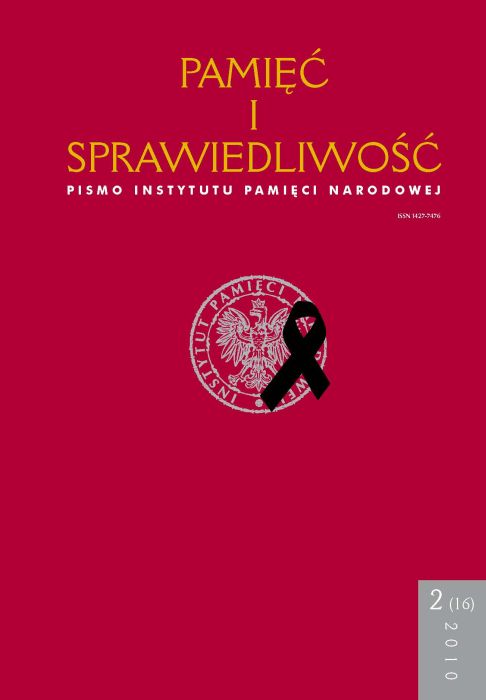Eksterminacja żydów wileńskich i dzieje getta wileńskiego (1941–1944)
Pamięć i Sprawiedliwość, V. 16 N. 2 (2010), pages: 229-272
Publication date: 2010-12-30
Abstract
The article gives a survey of the destruction of Vilnius Jews community, points out the most important stages in the history of Vilnius ghetto and typical features, provides statistics on victims, describes the inside structure of ghetto administration and its behavior, also activities by the anti-Nazi ghetto underground.
The history of Vilnius Jews community and the ghetto in the period of Nazi occupation can be split into several periods: 1) discrimination and massacre of the Jews before the establishment of the ghetto (24 June 1941–August 1941);
2) the period when the ghettos No. 1 and No. 2 were formed and mass massacre was executed (September 1941–November 1941); 3) stability period (December 1941–March 1943); 4) the period when the small ghettos, work camps and the Vilnius ghetto were removed (April–September 1943); 5) imprisonment of Vilnius ghetto residents in concentration camps in Estonia, and in work camps in Vilnius (October 1943–September 1944).
Discrimination and persecution of Vilnius Jews started from the very first days of Nazi occupation. Mass arrests and fusillades of Jews started in the middle of July 1941. The arrested would be first taken to Lukiškės prison and than to Paneriai (Ponary) to be fusilladed. The arrests and convoyment were executed by the German Gestapo, Lithuanian public police, self-defense units and the special squad members. The mass massacre in Paneriai would be usually performed by the special squad (Sonderkommando) subordinate to the German security police and SD. The biggest massacre took place at the initial stage of ghetto establishment and existence. In Vilnius, two ghettos were established. The big ghetto had about 29 thousand, and the smaller one about 9 thousand people imprisoned. Occupational power planned to let only the employable and qualified craftsmen
and their families stay alive. The rest Jews were to be subjected to fusillades. During several actions of October 1941, the small ghetto was finally removed. Nonetheless, mass killings continued to take place till the end of 1941. Since the beginning of the war up to 1942, about 33 thousand of Jews (from about 58 thousand Jews who lived before the war) were killed. About 15 thousand of
Jews remained in ghettos. Since the end of 1941 until March 1943, no mass killings were executed. This period became known as the stability (calm) period. Nazi authorities decided to leave the qualified workers and their families alive for some time. At this period, life in the ghetto became relatively normal and steady. The administrative system and daily work got settled. The ghetto became kind of “a state within a state” with its own authorities, police, manufactories, forms and institutions for spiritual and cultural life. Almost all men and women of employable age worked in different factories, manufactories and work camps. In summer 1943, about 14 thousand (two thirds of) ghetto residents had various kinds of occupations. In March 1943, the stability period in Vilnius ghetto came to an end. At that time, all small ghettos in Vilnius district were liquidated. Part of the residents were moved to Vilnius ghetto, others transported by train to Paneriai and fusilladed there (in total about 5 thousand people). In summer 1943, all provincial work camps of Vilnius ghetto were closed. During those Gestapo actions, several
hundreds were killed. In August 1943 gradual liquidation of Vilnius ghetto started. By the end of September 1943, the Vilnius ghetto was liquidated. The majority of women and children (about 5 to 7 thousand) were moved to concentration camps in occupied Poland and killed there. The Jewish men (about 2 thousand) were
taken to lagers in Estonia and young women taken to Keiserwald concentration camp near Riga, Latvia. In September 1944, Nazis killed Vilnius Jews imprisoned in Estonia. Fairly 2 to 3 thousand of Jews survived till the end of Nazi occupation and war.
 Język Polski
Język Polski
 English
English
 Deutsch
Deutsch
 Français (France)
Français (France)
 Italiano
Italiano
 Русский
Русский


 PDF (Język Polski)
PDF (Język Polski)
